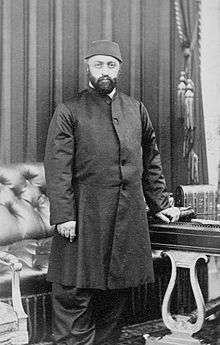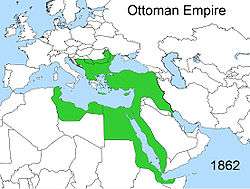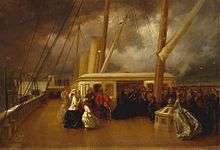Abdülaziz of the Ottoman Empire
| Abdülaziz of the Ottoman Empire | |
|---|---|
|
Caliph of Islam Amir al-Mu'minin Sultan of the Ottoman Empire Custodian of the Two Holy Mosques | |
 Sultan Abdülaziz during his visit to the United Kingdom in 1867 | |
| Sultan of the Ottoman Empire | |
| Reign | 2 June 1861 – 30 May 1876 |
| Predecessor | Abdülmecid I |
| Successor | Murad V |
| Born |
9 February 1830 Constantinople |
| Died |
4 June 1876 (aged 46)[1] Çırağan Palace |
| Consorts |
Dürrinev Kadınefendi Edadil Kadınefendi Hayranidil Kadınefendi Neşerek Kadınefendi Gevheri Kadınefendi |
| Royal house | House of Osman |
| Father | Mahmud II |
| Mother | Pertevniyal Sultan |
| Religion | Sunni Islam |
| Tughra |
|
Abdülaziz of the Ottoman Empire or Abdülaziz I (Ottoman Turkish: عبد العزيز / `Abdü’l-`Azīz, Turkish: I. Abdülaziz; 9 February 1830 – 4 June 1876) was the 32nd Sultan of the Ottoman Empire and reigned between 25 June 1861 and 30 May 1876.[1] He was the son of Sultan Mahmud II and succeeded his brother Abdülmecid I in 1861.[2]
Born at the Eyüp Palace, Constantinople (present-day Istanbul),[3][4] on 9/18 February 1830, Abdülaziz received an Ottoman education but was nevertheless an ardent admirer of the material progress that was made in the West. He was the first Ottoman Sultan who travelled to Western Europe, visiting a number of important European capitals including Paris, London and Vienna in the summer of 1867. The Sultan took an interest in documenting the Sultanate. He was also interested in literature and was also a classical music composer. Some of his compositions have been collected in the album "European Music at the Ottoman Court" by the London Academy of Ottoman Court Music.
Family

His parents were Mahmud II and Valide Sultan Pertevniyal ("Partav-Nihal").[5] (1812–1883), originally named Bezime, a Vlach.[6] He was a quarter French. In 1868 Pertevniyal was living in the Dolmabahçe Palace. That year Abdülaziz led the visiting Eugénie de Montijo, Empress of France, to see his mother. Pertevniyal perceived the presence of a foreign woman within her quarters of the seraglio as an insult. She reportedly slapped Eugénie across the face, almost resulting in an international incident.[7] According to another account, Pertevniyal became outraged by the forwardness of Eugénie taking the arm of one of her sons while he gave a tour of the palace garden, and she gave the Empress a slap on the stomach as a possibly more subtly intended than often represented reminder that they were not in France.[8] The Pertevniyal Valide Sultan Mosque was built under the patronage of his mother. The construction work began in November 1869 and the mosque was finished in 1871.[9]
His paternal grandparents were Sultan Abdul Hamid I and Sultana Naksh-i-Dil Haseki. Several accounts identify his paternal grandmother with Aimée du Buc de Rivéry, a cousin of Joséphine de Beauharnais.[10] Pertevniyal was a sister of Hoshiar (Khushiyar), third wife of Ibrahim Pasha of Egypt. Hoshiar and Ibrahim were the parents of Isma'il Pasha.[11][12][13][14][15]
Reign

Between 1861 and 1871, the Tanzimat reforms which began during the reign of his brother Abdülmecid I were continued under the leadership of his chief ministers, Mehmed Fuad Pasha and Mehmed Emin Âli Pasha. New administrative districts (vilayets) were set up in 1864 and a Council of State was established in 1868.[1] Public education was organized on the French model and Istanbul University was reorganised as a modern institution in 1861.[1] He was also integral in establishing the first Ottoman civil code.[1]

Abdülaziz cultivated good relations with the Second French Empire and the British Empire. In 1867 he was the first Ottoman sultan to visit Western Europe;[1] his trip included a visit to the United Kingdom, where he was made a Knight of the Garter by Queen Victoria and shown a Royal Navy Fleet Review with Ismail Pasha. He travelled by a private rail car, which today can be found in the Rahmi M. Koç Museum in Istanbul. His fellow Knights of the Garter created in 1867 were Charles Gordon-Lennox, 6th Duke of Richmond, Charles Manners, 6th Duke of Rutland, Henry Somerset, 8th Duke of Beaufort, Prince Arthur, Duke of Connaught and Strathearn (a son of Queen Victoria), Franz Joseph I of Austria and Alexander II of Russia.
Also in 1867, Abdülaziz became the first Ottoman Sultan to formally recognize the title of Khedive (Viceroy) to be used by the Vali (Governor) of the Ottoman Eyalet of Egypt and Sudan (1517–1867), which thus became the autonomous Ottoman Khedivate of Egypt and Sudan (1867–1914). Muhammad Ali Pasha and his descendants had been the governors (Vali) of Ottoman Egypt and Sudan since 1805, but were willing to use the higher title of Khedive, which was unrecognized by the Ottoman government until 1867. In return, the first Khedive, Ismail Pasha, had agreed a year earlier (in 1866) to increase the annual tax revenues which Egypt and Sudan would provide for the Ottoman treasury.[16] Between 1854 and 1894,[16][17] the revenues from Egypt and Sudan were often declared as a surety by the Ottoman government for borrowing loans from British and French banks.[16][17] After the Ottoman government declared a sovereign default on its foreign debt repayments on 30 October 1875,[16] which triggered the Great Eastern Crisis (1875–78) in the empire's Balkan provinces that led to the devastating Russo-Turkish War (1877–78) and the establishment of the Ottoman Public Debt Administration in 1881,[16] the importance for Britain of the sureties regarding the Ottoman revenues from Egypt and Sudan increased.[17] Combined with the much more important Suez Canal which was opened in 1869, these sureties were influential in the British government's decision to occupy Egypt and Sudan in 1882, with the pretext of helping the Ottoman-Egyptian government to put down the Urabi Revolt (1879–1882). Egypt and Sudan (together with Cyprus) nominally remained Ottoman territories until 5 November 1914,[18] when the British Empire declared war against the Ottoman Empire during World War I.[18]
In 1869, Abdülaziz received visits from Eugénie de Montijo, Empress consort of Napoleon III of France and other foreign monarchs on their way to the opening of the Suez Canal. The Prince of Wales, the future Edward VII, twice visited Constantinople.
By 1871 both Mehmed Fuad Pasha and Mehmed Emin Âli Pasha were dead.[1] The Second French Empire, his Western European model, had been defeated in the Franco-Prussian War by the North German Confederation under the leadership of the Kingdom of Prussia. Abdülaziz turned to the Russian Empire for friendship, as unrest in the Balkan provinces continued. In 1875, the Herzegovinian rebellion was the beginning of further unrest in the Balkan provinces. In 1876, the April Uprising saw insurrection spreading among the Bulgarians. Ill feeling mounted against Russia for its encouragement of the rebellions.[1]
While no one event led to his being deposed, the crop failure of 1873 and his lavish expenditures on the Ottoman Navy and on new palaces which he had built, along with mounting public debt, helped to create an atmosphere conducive to his being overthrown. Abdülaziz was deposed by his ministers on 30 May 1876;[1] his death at Feriye Palace in Constantinople a few days later was documented as a suicide at the time,[1][19] although in Sultan Abdulhamid II's recently surfaced memoirs, the event is described as an assassination by the order of Hüseyin Avni Pasha and Midhat Pasha. When Sultan Murad V began to show signs of paranoia, madness and continuous fainting and vomiting even on the day of his coronation and threw himself into a pool yelling at his guards to protect his life, they were afraid the public would become outraged and revolt to bring the former Sultan back. Within a few days, on 4 June 1876, they arranged for Sultan Abdülaziz to kill himself with scissors, cutting his two wrists at the same time.[20] It was unclear how the Sultan got hold of scissors in his tower prison cell and how he managed to cut two wrists at once, since no autopsy was allowed afterwards. The event was recorded as suicide officially and he was buried in Constantinople.
Achievements


- Abdülaziz gave special emphasis on modernizing the Ottoman Navy. In 1875, the Ottoman Navy had 21 battleships and 173 warships of other types, ranking as the third largest navy in the world after the British and French navies. His passion for the Navy, ships and sea can be observed in the wall paintings and pictures of the Beylerbeyi Palace on the Bosphorus strait in Istanbul, which was constructed during his reign. However, the large budget for modernizing and expanding the Navy (combined with a severe drought in 1873 and incidents of flooding in 1874 which damaged Ottoman agriculture and reduced the government's tax revenues) contributed to the financial difficulties which caused the Porte to declare a sovereign default with the "Ramazan Kanunnamesi" on 30 October 1875. The subsequent decision to increase agricultural taxes for paying the Ottoman public debt to foreign creditors (mainly British and French banks) triggered the Great Eastern Crisis (1875–78) in the empire's Balkan provinces, which culminated in the Russo-Turkish War (1877–78) that devastated the already struggling Ottoman economy, and the establishment of the Ottoman Public Debt Administration in 1881, during the early years of Sultan Abdülhamid II's reign.
- The first Ottoman railroads were opened between İzmir–Aydın and Alexandria–Cairo in 1856, during the reign of Sultan Abdülmecid I. The first large railway terminal within present-day Turkey, the Alsancak Terminal in Izmir, was opened in 1858. However, these were individual, unconnected railroads, without a railway network. Sultan Abdülaziz established the first Ottoman railway networks. On 17 April 1869, the concession for the Rumelia Railway (i.e. Balkan Railways, Rumeli (Rumelia) meaning the Balkan peninsula in Ottoman Turkish) which connected Istanbul to Vienna was awarded to Baron Maurice de Hirsch (Moritz Freiherr Hirsch auf Gereuth), a Bavaria-born banker from Belgium. The project foresaw a railway route from Istanbul via Edirne, Plovdiv and Sarajevo to the shore of the Sava River. In 1873, the first Sirkeci Terminal in Istanbul was opened. The temporary Sirkeci terminal building was later replaced with the current one which was built between 1888 and 1890 (during the reign of Abdülhamid II) and became the final destination terminus of the Orient Express. In 1871, Sultan Abdülaziz established the Anatolia Railway. Construction works of the 1,435 mm (4 ft 8 1⁄2 in) standard gauge on the Asian side of Istanbul, from Haydarpaşa to Pendik, began in 1871. The line was opened on 22 September 1872.[21] The railway was extended to Gebze, which opened on 1 January 1873. In August 1873 the railway reached Izmit. Another railway extension was built in 1871 to serve a populated area along Bursa and the Sea of Marmara. The Anatolia Railway was then extended to Ankara and eventually to Mesopotamia, Syria and Arabia during the reign of Sultan Abdülhamid II, with the completion of the Baghdad Railway and Hejaz Railway.
- Under his reign, Turkey's first postage stamps were issued in 1863, and the Ottoman Empire joined the Universal Postal Union in 1875 as a founding member.
- He also was responsible for the first civil code for the Ottoman Empire.[1]
- He was the first Ottoman sultan who travelled to Western Europe. His voyage in visiting order (from 21 June 1867 to 7 August 1867): Istanbul – Messina – Naples – Toulon – Marseille – Paris – Boulogne – Dover – London – Dover – Calais – Brussels – Koblenz – Vienna – Budapest – Orșova – Vidin – Ruse – Varna – Istanbul.[22]
- Impressed by the museums in Paris (30 June – 10 July 1867),[22] London (12–23 July 1867)[22] and Vienna (28–30 July 1867)[22] which he visited in the summer of 1867, he ordered the establishment of an Imperial Museum in Istanbul: the Istanbul Archaeology Museum.
- He was made the 756th Knight of the Order of the Garter in 1867 and the 127th Grand Cross of the Order of the Tower and Sword.
Family life

First marriage and issue
He married firstly at Dolmabahçe Palace, Constantinople on 20 May 1856 to Georgian HH Dürrinev Kadınefendi (Batumi, 15 March 1835 – Constantinople, Üsküdar, Çamlıca Palace, 3 December 1892), and they had three children, including Yusuf Izzettin Efendi. His non-spear great-grandson through him is the current crown prince of Kuwait.
Second marriage and issue
HH Edadil Kadınefendi (1845 – Dolmabahçe Palace, 12 December 1875) at the Dolmabahçe Palace in 1861 and they had one child.
Third marriage and issue
Circassian HH Gevheri Kadınefendi (Caucasus, 8 July 1856 – Ortaköy Palace, Ortaköy, Constantinople, 20 September 1894) in 1872 to and they had two children.
Fourth marriage and issue
Georgian HH Hayranidil Kadınefendi (Kars, 2 November 1846 – Ortaköy Palace, Constantinople, 26 November 1898) at the Dolmabahçe Palace, Constantinople, on 21 September 1866 and they had two children.
- Caliph Abdülmecid II
Fifth marriage and issue
Georgian HH Neşerek Kadınefendi (Tbilisi, 1848 – 11 June 1876 - Ortaköy Palace, Constantinople) at the Dolmabahçe Palace, in 1868 and they had three children.[23]
References
- 1 2 3 4 5 6 7 8 9 10 11 Hoiberg, Dale H., ed. (2010). "Abdülaziz". Encyclopædia Britannica. I: A-ak Bayes (15th ed.). Chicago, IL: Encyclopædia Britannica Inc. p. 21. ISBN 978-1-59339-837-8.
- ↑ Chambers Biographical Dictionary, ISBN 0-550-18022-2, page 2
- ↑ The Encyclopædia Britannica, Vol.7, Edited by Hugh Chisholm, (1911), 3; İstanbul, the capital of the Turkish Empire...
- ↑ Britannica, Istanbul:When the Republic of Turkey was founded in 1923, the capital was moved to Ankara, and Constantinople was officially renamed Istanbul in 1930.
- ↑ Daniel T. Rogers, "All my relatives: Valide Sultana Partav-Nihal"
- ↑ His profile in the Ottoman Web Site
- ↑ "Women in Power" 1840-1870, entry: "1861-76 Pertevniyal Valide Sultan of The Ottoman Empire"
- ↑ Duff 1978, p. 191.
- ↑ "Pertevniyal Valide Sultan Mosque Complex". Discover Islamic Art. Retrieved 26 January 2008.
- ↑ Christine Isom-Verhaaren, "Royal French Women in the Ottoman Sultans' Harem: The Political Uses of Fabricated Accounts from the Sixteenth to the Twenty-first Century"
- ↑ Christopher Buyers, "The Muhammad 'Ali Dynasty Genealogy"
- ↑ Non European Royalty Website, entry:"Egypt"
- ↑ "Women in Power" 1840-1870, entry: "1863-79 Valida Pasha Khushiyar of Egypt"
- ↑ Rulers from the House of Mohammed Aly
- ↑ Genealogical entry: "Hoshiar Walda Pasha"
- 1 2 3 4 5 Mevzuat Dergisi, Yıl: 9, Sayı: 100, Nisan 2006: "Osmanlı İmparatorluğu'nda ve Türkiye Cumhuriyeti'nde Borçlanma Politikaları ve Sonuçları"
- 1 2 3 Article 18 of the Treaty of Lausanne (1923)
- 1 2 Articles 17, 18, 19, 20 and 21 of the Treaty of Lausanne (1923)
- ↑ Davis, Claire (1970). The Palace of Topkapi in Istanbul. New York: Charles Scribner's Sons. p. 222. ASIN B000NP64Z2.
- ↑ Bozdağ, İsmet (2000). Sultan Abdülhamid'in Hatıra Defteri. İstanbul: Pınar Yayınları. p. 223. ISBN 9753520344.
- ↑ CFOA History - Trains and Railways of Turkey
- 1 2 3 4 Voyage of Sultan Abdülaziz to Europe (21 June 1867 – 7 August 1867)
- ↑ http://freepages.genealogy.rootsweb.com/~royalty/turkey/i339.html i339.html
![]() This article incorporates text from a publication now in the public domain: Chisholm, Hugh, ed. (1911). "Abd-ul-Aziz". Encyclopædia Britannica (11th ed.). Cambridge University Press.
This article incorporates text from a publication now in the public domain: Chisholm, Hugh, ed. (1911). "Abd-ul-Aziz". Encyclopædia Britannica (11th ed.). Cambridge University Press.
- Finkel, Caroline, Osman's Dream, (Basic Books, 2005), 57; "Istanbul was only adopted as the city's official name in 1930..".
External links
![]() Media related to Abdül Aziz I at Wikimedia Commons
Media related to Abdül Aziz I at Wikimedia Commons
![]() Works written by or about Abd-ul-Aziz at Wikisource
Works written by or about Abd-ul-Aziz at Wikisource
-
 "Abd-ul-Aziz". Collier's New Encyclopedia. 1921.
"Abd-ul-Aziz". Collier's New Encyclopedia. 1921.
| Abdülaziz of the Ottoman Empire Born: 9 February 1830 Died: 4 June 1876 | ||
| Regnal titles | ||
|---|---|---|
| Preceded by Abdülmecid I |
Sultan of the Ottoman Empire 25 Jun 1861 – 30 May 1876 |
Succeeded by Murad V |
| Sunni Islam titles | ||
| Preceded by Abdülmecid I |
Caliph of Islam 25 Jun 1861 – 30 May 1876 |
Succeeded by Murad V |
| ||||||||||||||
|